We think we know workplace stress. We avoid it, we are overwhelmed by it, we relish it, we handle it, we thrive from it. But do we really understand it?
According to Cal/OSHA guidelines, harmful workplace stress arises in “jobs that demand a lot from the employees, while allowing them little control over how the job is performed” and “organizational practices that exclude employee participation or input.”
This definition makes clear that harmful stress isn’t just the looming deadline, overloaded inbox, budget crunch or commuter traffic on the way to work. Stress involves having too much responsibility for those problems in the workplace over which we have too little control. Running an international banking consortium might not be as harmfully stressful as working in a mail room with inefficient equipment.
How our jobs create stress
Studies confirm that workers who perceive they are subjected to high demands but have little control are at increased risk for cardiovascular disease. Today’s U.S. workers work longer hours than ever (three months per year longer than their German counterparts and one month longer than workers in Japan), according to the American Institute of Stress. That leaves more opportunity for stress to develop.
Harmful stress isn’t just the looming deadline, overloaded inbox, budget crunch or commuter traffic on the way to work. Stress involves having too much responsibility for those problems in the workplace over which we have too little control.
Statistics from the American Psychological Association Center for Organizational Excellence revealed that 65 percent of employees cited work as a significant source of psychological symptoms of stress, which may include depression, anxiety, agitation, moodiness, anger, a feeling of being overwhelmed, loneliness and isolation. Even worse, more than a third experience chronic stress, which includes physical symptoms such as low energy, headaches, upset stomach, tense muscles, chest pain, insomnia, and frequent colds and infections.
The APA also researched the causes of stress in the U.S., finding “job pressure” to be No. 1. That includes factors such as coworker tension, bosses and work overload. Money, which includes loss of job and reduced retirement, came in as the second factor. Health, relationships and poor nutrition round out the top five. Most of these stressors seem to be outside of our control, resulting in dangerously harmful stress in our lives.
But are they really? Laurie Erdman, a business coach, writer and speaker, has a different take: Stress begins in our minds via a thought or belief. Stress doesn’t come from the environment outside; it comes from inside. If that definition sounds a bit simplistic, it alludes to the fact that the job alone is not the only stressor. The relationship between the person and the environment also matters. Some people may thrive in a time-urgent, pressure-cooker life, as long as they perceive themselves as in control. These same people would become ill if forced to work on an assembly line with no expectations and no responsibility.
How employees can take ownership of their stress
- Every individual is different, and what works for you might not work for your peers, but here are some practical tips to get you started:
- Train yourself to neutralize stress through understanding what it is and from where it comes.
- Practice stress. Repeated exposure to stressful situations can change your body’s biological response. When your stress hormones become less responsive, you will handle stress better when it inevitably arises.
- Replace harmful thoughts with more positive, gratitude-filled thoughts.
- Meditate, exercise, eat healthy. Taking care of your body makes you more adept at handling the psychological impact of stress.
The greatest tool is acknowledgement that perhaps it’s not just your job or your boss, but rather how well you identify impossible demands and take ownership of your responses to them.
How managers can help
Given the deleterious effects of stress in the workplace on employee health, morale and productivity, managers must also do what they can to increase their employees’ sense of control.
- Listen. The act of listening can help increase an employee’s sense of control.
- Encourage workplace camaraderie by making time for socialization during and after business hours.
- Help employees strategize workflow, replacing multitasking with “serial mono-tasking,” in which employees dedicate their focus and attention to one task at a time, therefore eliminating distractions and frantic thoughts.
- Limit unplanned overtime.
- Consider more flextime options so employees can work in various environments that allow them to reduce stress.
The stakes are high. Awareness that “helplessness” and “lack of control” are the villains in this scenario will lead managers and employees to identify and alleviate at least some of the causes.



